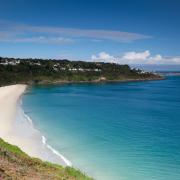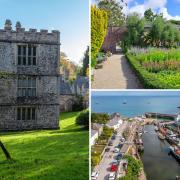
From St Piran’s Day celebrations in Australia to pasty shacks in Canada - the footprints of Cornwall’s émigrés can be traced all over the world. Discover the Cornish Diaspora through the eyes of one family’s journey
We all love the idea of tracing our ancestors to discover amazing stories – tales of heroes and heroines in war and peace - perhaps a royal connection or two. But a new book by Max Beck proves that everyone has an amazing story to tell – it’s just a question of research.
A Different Earth tells an amazing story based on the real life experiences of a Cornish mining family who left the county in 1848 to escape the poverty and starvation caused by the potato blight in search of a new life in Australia.

But like every good story , we will begin at the beginning with the first Cornishman to arrive in Australia, who was probably Zachary Hicks in 1770 - second-in-command on Lieutenant James Cook on his famous HMS Endeavour (eastern Australia’s Point Hicks is named in his honour). He was quickly followed by a cast of less heroic characters including convict James Ruse in 1788 – who was given seven years transportation to Australia for breaking and entering (he was eventually given land in New South Wales).
Less than a century later, tens of thousands of people chose to travel across the world to escape the harshness of life in Cornwall. Today Cornish Australians are thought to make up around 4.3 per cent of the Australian population - making them one of the largest ethnic groups in Australia. And behind those ancestors there are scores of stories.
The Cornish Diaspora is an important element of the Gorsedh Kernow and each year Cornish people from the Americas, Australia and New Zealand are honoured with bardship for their services to Cornwall and her culture,’ explains Merv Davey, Cornwall’s current Grand Bard - the closest thing Cornwall has to a king. The global impact of Cornish technology is celebrated through recognition of Cornwall as a World Heritage Site for mining and of course the School of Mines, now at Tremough Campus in Penryn, remains a world leader in teaching mining technology. The Cornish Language and 19th Century dialect is still to be found in mining terms around the globe (now there is a research project for someone!). Cornish technology and engineers sorted London’s water management problems in the 19th Century and the diseases that went with them and the enigmatic Jinjys (engine houses) are still to be seen worldwide.
There is also a forgotten social history here. The miners who sought employment overseas during the late 19th century decline in Cornwall’s mining often left behind wives and families. Contrary to the conventions of the Victorian era these women became heads of households and enjoyed a sense of independence that led to an early start for the women’s suffrage movement in Cornwall. This movement was sufficiently strong for radical Liberal politician, Charles Conybeare to be elected to Parliament in 1885, representing Camborne and Redruth, on a platform that included votes for women and home rule for Cornwall.’

So perhaps it’s fitting that A Different Earth centres on the story of one of this strong Cornish women - Jane Dunstan by her the great, great grandson Max Beck. He charts the gruelling life of the family of Jane, her husband Richard and their seven children as they decide to become part of Cornwall’s 19th century great emigration’ to Australia. Told uniquely from the perspective of Jane, who was born in Wendron 1814, the book reflects mining life in all its hardships, the challenges of bringing up seven children in a tiny, self-built cottage in Tolcarne and the devastation caused by the potato blight that led them, like so many others, to become pioneer miners in Australia. My father was a hotel-keeper for 41 years during which time he was the proprietor of two pubs in Victoria, Australia, with the very British sounding names of The Crown Hotel and The Imperial Hotel,’ says Max. He was a great raconteur with a great repertoire of stories he could tell all day. One of his stories was a larger than life account about my great, great grandmother, Jane Dunstan. He was the sort of bloke that never let the truth get in the way of a good yarn. But every time he told this story, unlike many of his other yarns, it always was the same.
My imagination was captivated by the vision of a powerful little Cornish lady who having lost her husband decided to walk 550 miles with her six children overland through the bush from Adelaide in South Australia to the goldfields in Victoria. The story seemed almost beyond belief. I resolved that when I retired one day I would check out the veracity of the tale he told. When I did I found that it was true and amazingly so. Indeed, there was a great deal more to it than my father knew.’
The story starts in the parish of Wendron in Cornwall. The 1841 UK Census showed that the family lived in a tiny hamlet, called Tolcarne, with 15 cottages that housed 78 people. It existed to serve the mines and was a mining camp more than anything else. Each tiny mud brick dwelling housed a poor family. With the passage of time the cottages have melted back into the earth and the site of the hamlet is now open fields.
The family sailed 16 October 1848 aboard the triple mastered barque Trafalgar. Jane was then 33 years of age and had seven children aged from 11 years down to a baby a few months old. Her husband Richard supported the family working in the tin and copper mines.

But in 1848 they were in the middle of a potato famine in Cornwall. Peasant Cornish miners relied on them as much as the Irish did and when the spuds rotted in the ground Cornish mining families went hungry. Alongside this was the threat of mining - many miners died by the time they were 45 from a variety of causes - in some parishes 28 per cent were dead before they were 30. Britain was suffering an economic depression which resulted in the closure of many mines in Cornwall resulting in much unemployment and suffering. Jane and her husband were both illiterate but she battled her way through government regulations to eventually obtain assisted passages to Adelaide for her family.
Having spent three months living in appalling conditions aboard a ship, the family arrive in Australia, where, working in the copper mines, they are forced to live in a home hollowed out from the banks of the Burra Creek before death strikes the family killing Jane’s husband Richard and two of her daughters.
When gold is discovered in Victoria in 1855 she decides to take her remaining family on a 550-mile, six-week trek on foot with bullock cart to carry their belongings, through the Australian bush where, upon arriving in the goldfields, she is horrified by what she sees.
It is an epic story of a truly amazing Cornish woman. Author Max who practised as a barrister and solicitor. magistrate and coroner in Victoria, spent five years researching and writing the book.

He visited Cornwall, corresponded with researchers checking the records of Lloyds of London as well as endless research in libraries. As Jane and her husband were both illiterate, they left no diaries,’ he says. To excavate their story I read the diaries of numerous other pioneers who made similar journeys at the time. I made several trips to Burra, South Australia, where Jane and her family lived in an underground dugout on the banks of the Burra Creek and her husband Richard and their boys worked in the copper mine. I investigated and followed the route I believe they took walking overland from Burra to the Victorian goldfields.
Finally, I spent a week on board the tall sailing ship Windeward Bound, a Boston-style brigantine, sailing south and west out of Hobart Tasmania into the roaring 40s in order to experience the reality of the sea in such a vessel.
It has been an amazing experience to retrace my family steps and chart what is a remarkable story of courage, perseverance, tragedy and ultimately a settled and happy life.
It was also an opportunity to see where the family lived, although the cottage at Tolcarne they built has long since gone. I also visited other locations in Australia and even spent a week aboard a tall ship to get a feel for life at sea, so it has been a real labour of love!
What struck me most on researching and telling the story of Jane was just how difficult life – both in Cornwall and then in Australia – was,’ he adds. w
Published by Cornwall Editions, A Different is Earth is available from all good bookshops and from £16.99


























